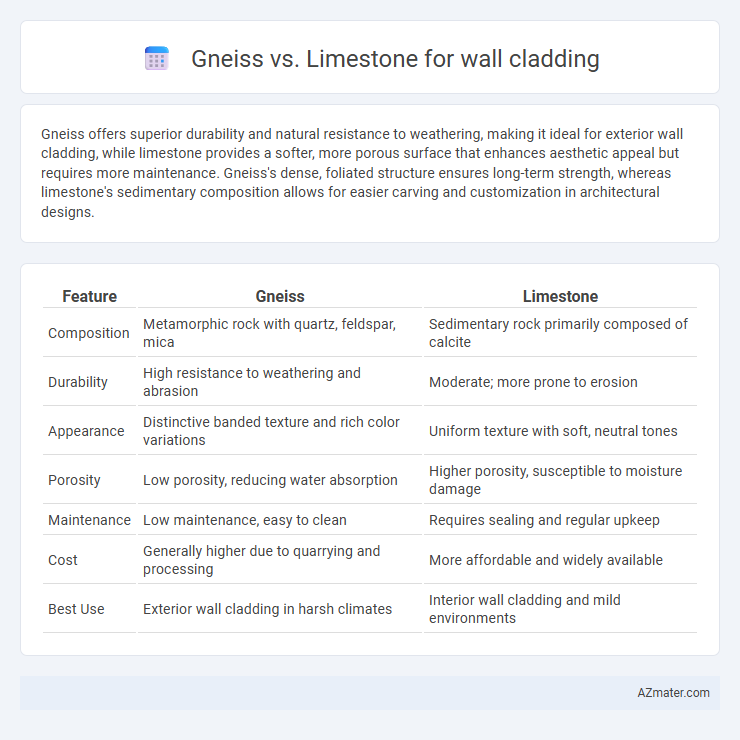Gneiss offers superior durability and natural resistance to weathering, making it ideal for exterior wall cladding, while limestone provides a softer, more porous surface that enhances aesthetic appeal but requires more maintenance. Gneiss's dense, foliated structure ensures long-term strength, whereas limestone's sedimentary composition allows for easier carving and customization in architectural designs.
Table of Comparison
| Feature | Gneiss | Limestone |
|---|---|---|
| Composition | Metamorphic rock with quartz, feldspar, mica | Sedimentary rock primarily composed of calcite |
| Durability | High resistance to weathering and abrasion | Moderate; more prone to erosion |
| Appearance | Distinctive banded texture and rich color variations | Uniform texture with soft, neutral tones |
| Porosity | Low porosity, reducing water absorption | Higher porosity, susceptible to moisture damage |
| Maintenance | Low maintenance, easy to clean | Requires sealing and regular upkeep |
| Cost | Generally higher due to quarrying and processing | More affordable and widely available |
| Best Use | Exterior wall cladding in harsh climates | Interior wall cladding and mild environments |
Introduction to Gneiss and Limestone
Gneiss, a high-grade metamorphic rock characterized by its distinct banding and coarse grain, offers exceptional durability and aesthetic appeal for wall cladding. Limestone, a sedimentary rock primarily composed of calcite, showcases a smooth texture and natural light coloration, providing a classic and elegant finish for exterior and interior walls. Both materials demonstrate unique physical properties and weather resistance, influencing their suitability for different architectural styles and environmental conditions.
Geological Formation and Composition
Gneiss, a metamorphic rock formed under high temperature and pressure conditions, exhibits a banded texture composed mainly of quartz, feldspar, and mica, making it highly durable for wall cladding. Limestone, a sedimentary rock primarily composed of calcite derived from marine organisms, tends to have a softer texture and more uniform composition, affecting its weather resistance and suitability in different climatic conditions. The metamorphic origin of gneiss gives it enhanced structural strength and abrasion resistance compared to the more porous and reactive nature of limestone.
Aesthetic Differences: Texture and Color
Gneiss wall cladding features a distinctive foliated texture with banded patterns and a natural sheen, offering a dynamic blend of earthy tones such as gray, brown, and pink that enhance architectural elegance. Limestone cladding presents a smoother, more uniform texture with subtle fossil imprints and a pale color palette ranging from creamy whites to soft beige, contributing to a classic, refined appearance. The contrast between gneiss's rugged, multi-tonal surface and limestone's gentle, monochromatic finish allows designers to choose materials that best complement either bold, natural aesthetics or understated, timeless elegance.
Durability and Weather Resistance
Gneiss offers exceptional durability and superior weather resistance for wall cladding due to its high quartz content and foliated structure, making it highly resistant to abrasion and chemical weathering. Limestone, while aesthetically attractive and easier to work with, is more porous and susceptible to acid rain and freeze-thaw cycles, which can lead to surface degradation over time. For exterior applications requiring longevity and minimal maintenance, gneiss is the preferred choice due to its strength and resistance to environmental stressors.
Installation Process and Techniques
Gneiss wall cladding requires precise cutting and anchoring techniques to accommodate its foliated texture and layered structure, ensuring stability and aesthetic alignment. Limestone, being softer and more porous, demands careful handling with waterproofing treatments and the use of mortar-based adhesives to prevent moisture absorption and enhance adhesion. Both materials benefit from mechanical fixing systems, but gneiss often involves heavier anchors due to its density, whereas limestone's installation prioritizes protection against weathering.
Maintenance and Longevity
Gneiss offers superior durability and low maintenance for wall cladding due to its dense, crystalline structure that resists weathering, stains, and scratches. Limestone requires more frequent sealing and careful cleaning to prevent erosion and staining from moisture and pollutants, impacting its longevity over time. Gneiss's inherent hardness and weather resistance make it a longer-lasting, cost-effective option for exterior cladding compared to softer, more porous limestone.
Cost Comparison and Budget Considerations
Gneiss wall cladding generally incurs higher initial costs compared to limestone due to its durability and complex quarrying process, making it suitable for long-term investment in premium projects. Limestone offers a more budget-friendly alternative with moderate durability and easier installation, appealing to cost-sensitive homeowners and commercial clients. Evaluating lifecycle expenses, including maintenance and replacement, is essential for informed budget planning when selecting between gneiss and limestone cladding.
Environmental Impact and Sustainability
Gneiss offers superior environmental benefits for wall cladding due to its natural durability and low maintenance, reducing the need for frequent replacements and energy-intensive treatments. Limestone, while aesthetically pleasing, has a higher carbon footprint from quarrying and processing, and it is more susceptible to weathering, which can lead to increased environmental degradation over time. Choosing gneiss supports sustainability initiatives by minimizing resource consumption and promoting longer lifespan in construction projects.
Popular Applications in Wall Cladding
Gneiss is favored for wall cladding in residential and commercial buildings due to its durability, unique banded appearance, and resistance to weathering, making it ideal for exterior walls and accent facades. Limestone is widely used in historical and modern architecture, offering a smooth, elegant texture suitable for interior feature walls and decorative facades in cultural landmarks and upscale developments. Both materials provide distinctive aesthetic appeal, but gneiss excels in rugged outdoor environments while limestone is preferred for refined, classic finishes.
Choosing the Right Stone for Your Project
Gneiss offers exceptional durability and a unique banded appearance, making it ideal for wall cladding in both residential and commercial projects requiring a natural, textured aesthetic. Limestone provides a softer, more uniform look with excellent workability, suited for traditional or classic architectural styles but may require more maintenance due to its porosity. Selecting the right stone depends on factors including climate exposure, desired visual impact, and budget, with gneiss favored for longevity and strength while limestone excels in elegance and ease of installation.

Infographic: Gneiss vs Limestone for Wall cladding
 azmater.com
azmater.com